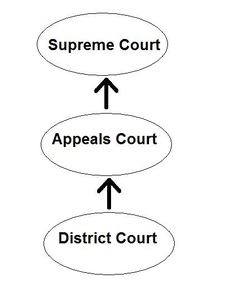The Three Branches of Government
Federal Court System

*The Federal Court System is based on a three tiered system starting with the District Court. A helpful acronym when studying the Federal Court System is S.A.D.
*Cases tried in Federal court:
1. Crimes committed on a ship at sea
2. State vs. State lawsuits
3. Breaking a law that Congress created
4. Violating the U.S. Constitution
5. Violating a U.S. treaty
6. Lawsuits from citizens of different states. (most common)
*Cases tried in Federal court:
1. Crimes committed on a ship at sea
2. State vs. State lawsuits
3. Breaking a law that Congress created
4. Violating the U.S. Constitution
5. Violating a U.S. treaty
6. Lawsuits from citizens of different states. (most common)
District Courts
*There are 94 in the United States, and all are trial courts with a Judge, defendent, attourney and jury.
*District courts have General Jurisdiction, meaning they hear cases involving a wide range of issues
*District courts have General Jurisdiction, meaning they hear cases involving a wide range of issues
Appeals Courts
*These courts fix flaws and mistakes.
*There are 13 appeals courts in the United States.
*Are NOT trial courts, but instead consist of a panel of three to seven judges and determines if the trial court or judge made a mistake.
*Appeals courts do NOT determine guilt or innocense.
*There are 13 appeals courts in the United States.
*Are NOT trial courts, but instead consist of a panel of three to seven judges and determines if the trial court or judge made a mistake.
*Appeals courts do NOT determine guilt or innocense.
Supreme Courts
*Highest court in the land
*Consists of 9 judges, 8 of whom are associate justices and one who is the chief justice.
*They hear appeals from the Appeals Courts and from the State Supreme Courts
*Supreme Court decides which cases to hear, and they only hear less than half of 1% of all cases presented to them. they also decide which cases to hear based on the "rule of 4" or having four of the nine judges say they want to hear the case.
*They also pick cases on three factors:
1. When two lower courts conflict
2. If a ruling conflicts with a previous Supreme Court Ruling
3. If the issue has historical significance
*When deciding on their decision about a case, the Supreme Court has a few options:
1. Can agree with the lower cases ruling
2. Can reverse the decidion of lower court
3. Can send it back to trial court
*Consists of 9 judges, 8 of whom are associate justices and one who is the chief justice.
*They hear appeals from the Appeals Courts and from the State Supreme Courts
*Supreme Court decides which cases to hear, and they only hear less than half of 1% of all cases presented to them. they also decide which cases to hear based on the "rule of 4" or having four of the nine judges say they want to hear the case.
*They also pick cases on three factors:
1. When two lower courts conflict
2. If a ruling conflicts with a previous Supreme Court Ruling
3. If the issue has historical significance
*When deciding on their decision about a case, the Supreme Court has a few options:
1. Can agree with the lower cases ruling
2. Can reverse the decidion of lower court
3. Can send it back to trial court
